Acer palmatum, commonly known as Japanese maple, palmate maple, or smooth Japanese maple, is a species of woody plant native to Japan, Korea, China, eastern Mongolia, and southeast Russia. The tree is characterized by a low growth habit, usually staying under 20 feet tall, and deeply dissected palmate leaves, which may be up to 5-inches long. Japanese maple requires specific cultural conditions in order to reach their full ornamental potential.Japanese maples are understory trees, which means they grow in the dappled shade under taller trees; usually evergreens. Some cultivars tolerate full sun better than others.
- Bloodgood
- Red Dragon
- Coral Bark
- Osakazuki
- Fireglow
- ‘Burgundy Lace’
- Oregon Sunset
- Crimson Queen
- Golden Fullmoon
- Beni kawa
- Coonara Pygmy
- Higasayama
- Viridis
- Butterfly
- Pacific Fire vine
- Villa Taranto
- Atropurpureum
- Emporor
- ‘Inaba-Shidare’
- Koshimino
Bloodgood Japanese Maple

The Bloodgood Japanese maple stays relatively small, reaching 20 feet high and wide, developing multiple twisting trunks with grey bark.It has a low canopy with a typical clearance of 4 feet from the ground, and is suitable for planting under power lines. It grows at a slow rate, and under ideal conditions can be expected to live for 80 years or more.
Bloodgood Japanese Maple has attractive burgundy foliage which emerges deep purple in spring. The lobed palmate leaves are highly ornamental and turn an outstanding scarlet in the fall. It features subtle corymbs of red flowers rising above the foliage in mid spring before the leaves. It produces red samaras from early to mid fall. The rough gray bark and red branches add an interesting dimension to the landscape.
Red Dragon Japanese Maple

Red Dragon’ is only one of a range of beautiful Japanese maple varieties featuring deeply cut leaves in vivid colors. The tree stay diminutive, and is often referred to as a dwarf tree, but it’s more accurately labeled as “compact” and “slow-growing.” It can mature to 8 feet tall and wide, but after a decade of growth, it usually isn’t taller than 5 feet. Still, its grace and vivid red foliage create a stunning focal point in your garden. It starts with bright red, cherry-colored leaves in the spring that become darker over the summer and turn scarlet in the fall. This deciduous tree also grows well in containers.
Like most Japanese maples, ‘Red Dragon’ likes a partly shady location, although it has no problem with full sun in cooler areas. The hotter the summers in your location, the more shade it appreciates. Excellent drainage is also a must, since these trees will not thrive and may not even survive in standing water.
Sango-Kaku Japanese Maple

The Sango-Kaku Japanese maple commonly known as the coral bark maple, provides a focal point in the garden to cheer even the gloomiest day. The name “Sango-kaku” translates to “coral-painted.” Coral bark Japanese maple is a slow-to-moderate-growing woody tree. It will grow to be about 20 feet tall at maturity, with a spread of 15 feet. This cultivar is noted for its coral-red bark that is particularly showy in the fall and winter after the leaves drop.
Its graceful branches, bare during the cold winter months, wrap themselves in bright green palmate leaves in spring through summer and yellow to light red foliage in fall. The tree features subtle corymbs of red flowers rising above the foliage in mid spring before the leaves. It produces red samaras from early to mid fall. The rough gray bark and coral-pink branches are extremely showy and add significant winter interest.
Also Read: Major Types of Flowering And Fruiting Crabapples
Osazuki Japanese Maple

This Japanese maple is an excellent small specimen tree grown mainly for its spectacular autumn colour, perhaps the best of all the maples. It is a tree with gracefully branched stems and lovely, deeply lobed, bright green leaves that emerge olive-orange in spring, and turn a brilliant crimson red in the fall, holding the color for several weeks.
‘Osakazuki’ has a rounded form and grows 15 to 24 feet tall. It prefers rich, moist, acidic soil, but will adapt to clay and sandy soils. In a sheltered, shady spot, ‘Osakazuki’ looks dramatic silhouetted against a tall hedge or modern building. It is suitable for growing in small gardens.
Fireglow Japanese Maple
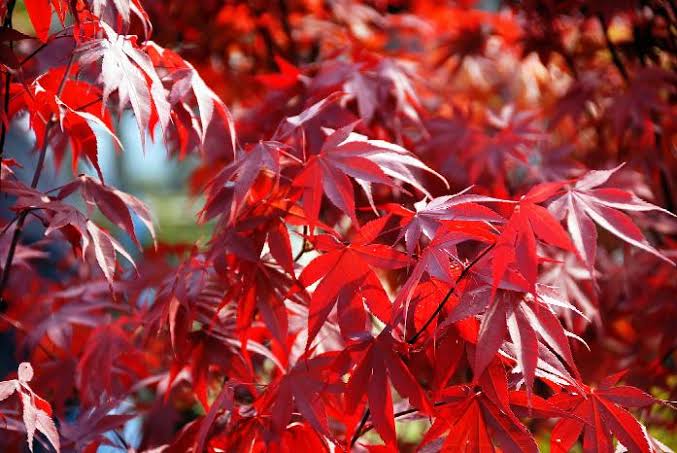
Fireglow Japanese Maple will grow to be about 10 feet tall at maturity, with a spread of 10 feet. It grows at a slow rate, and under ideal conditions can be expected to live for 60 years or more. It makes a fine choice for the outdoor landscape, but it is also well-suited for use in outdoor pots and containers. Because of its height, it is often used as a ‘thriller’ in the ‘spiller-thriller-filler’ container combination
Fireglow Japanese Maple has attractive red foliage which emerges burgundy in spring. The small lobed palmate leaves are highly ornamental and turn outstanding shades of purple, scarlet and crimson in the fall. Neither the flowers nor the fruit are ornamentally significant.
Burgundy Lace Japanese Maple
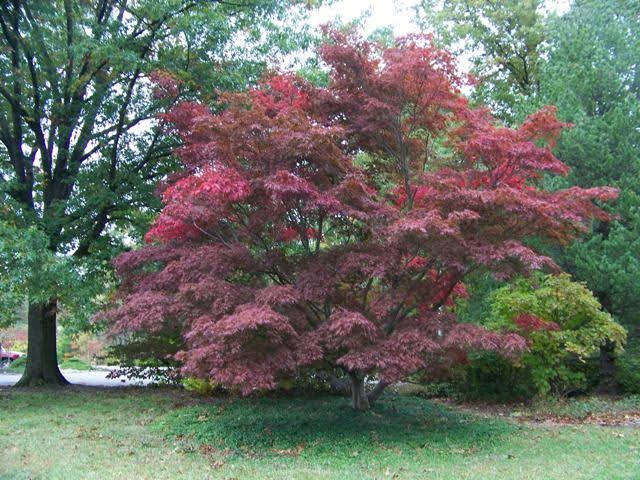
Acer palmatum ‘Burgundy Lace’ is a striking variety most often grown for its purple-red colored leaves, interesting growth habit, and fine leaf texture. This medium-size tree of spreading habit has almost ribbonlike lobes and burgundy wine coloured foliage. The multiple trunks are picturesque, grey, and show nicely when lit up at night. A perfect plant to grow in a pot or to add Japanese feel to the garden.
Burgundy Lace’ can reach 6 m in height and spread. Although upright, it is classed in the smaller tree group. Hardy and beautiful, it makes an excellent contrast with other upright cultivars.Like all Maples, this one is very easy to maintain.This compact cultivar makes a wonderful accent for any landscape.
Also Read: Major Various types of Cherry Trees
Oregon Sunset Japanese Maple
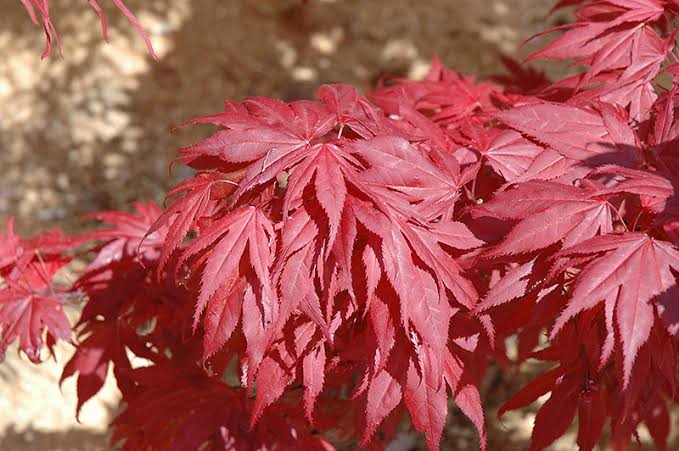
The Oregon Sunset Japanese Maple is a newer variety of these ever-popular trees, with a broad, sturdy form. It grows steadily into a bush 4-foot tall after 10 years, and as wide or a little wider. The leaves are divided into narrow ‘fingers’, and carried in tufts on the ends of the branches. This tree has a very attractive form, without being weeping, and makes the perfect specimen for your garden, or planted in a pot.
The leaves begin in spring as a soft, light red, turn plum-red for the summer, and then take on many shades of bright red in fall. The fall color is like a spectacular sunset, and the spring color is like a mellow – and this explains why this variety is called ‘Oregon Sunset’. Use it in the foreground of a bed of larger shrubs, as a specimen, and of course as a center-piece in your Asian-themed garden design.
Inaba-Shidare Japanese Maple
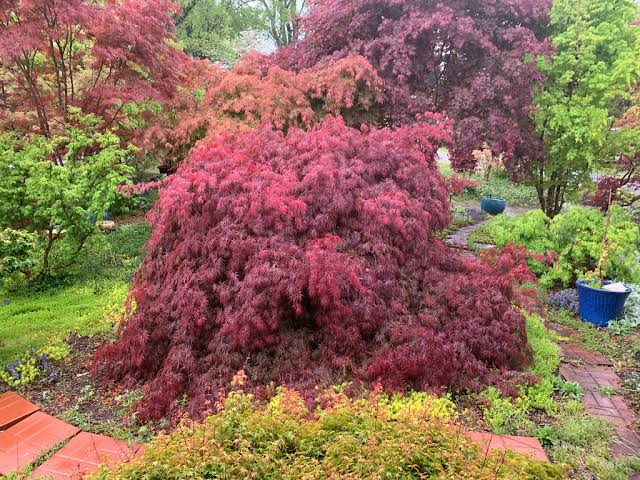
Inaba-shidare is one of multiple varieties of Japanese maples described as “dissected,” a term used for trees that have deeply cut, featherlike leaves. As is the case with other dissected versions of this tree, Inaba-shidare Japanese maple height rarely exceeds 12 feet, though its spread can reach up to 15 feet. The Inaba-shidare variety is superior when it comes to retaining its color throughout the summer. The leaves start off purple and are red by fall. The tree produces small flowers similar in color to its leaves in the summer, but they can only be appreciated up close.
Crimson Queen Japanese Maple

Crimson Queen is a Japanese maple of the dissectum type, meaning its foliage is deeply cut, with fernlike leaves. Befitting its cultivar name, the deciduous foliage is burgundy purple all growing season, changing to brilliant red in the fall. Though the tree is adaptable to higher zones if summer temperatures are mild. In higher zones, foliage is more likely to be bronze-green than burgundy during the growing season.
Crimson Queen maples are dwarf trees or multi-stemmed shrubs with weeping branches. The tree has graceful branches that curve downward with a crown that reaches only 8 to 12 feet tall and up to 10 feet wide. It has very small red flowers called samaras in the spring. The Crimson Queen Japanese Maple will thrive in the shade of larger trees, or on the north side of your home, bringing grace and color from spring to fall.
Also Read: Different Types of Trees With White Bark
Golden Full Moon Japanese Maple

The Golden Full Moon Japanese Maple is a striking and beautiful small tree, reaching 15 feet tall, and the same across. It has a low canopy with a typical clearance of 2 feet from the ground, and is suitable for planting under power lines. It grows at a slow rate, and under ideal conditions can be expected to live for 60 years or more.Its average texture blends into the landscape, but can be balanced by one or two finer or coarser trees or shrubs for an effective composition.
The leaves are broader than most Japanese Maples, with 9 to 13 shallow lobes, and in spring they are yellow with a thin red edge. They turn chartreuse-green in summer, and brilliant oranges and reds in fall. Trees develop small red flowers and clusters of red maple keys in winter. This is an ideal tree for sun or partial shade, and the perfect focal point in a woodland garden. Use it to complete your Asian-themed garden, as a tree on a small lawn area, or you can grow it in a large container on a terrace.
Beni Kawa Japanese Maple
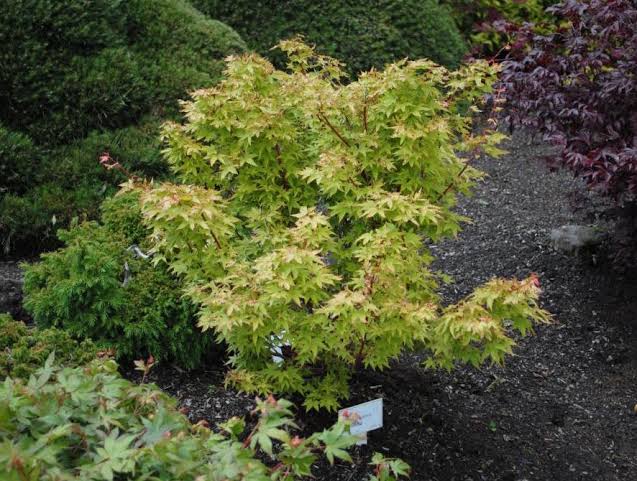
Beni-kawa’ is most noted for its coral red trunk and stems. It typically grows in an upright, rounded, shrubby form to 5-7 feet tall over the first 10 years, but eventually matures over time to 12-15 feet tall. It has a low canopy with a typical clearance of 2 feet from the ground, and is suitable for planting under power lines. It grows at a slow rate, and under ideal conditions can be expected to live for 60 years or more.
Beni Kawa Coral Bark Japanese Maple has attractive light green foliage edged in red which emerges chartreuse in spring. The small lobed palmate leaves are highly ornamental and turn outstanding shades of gold, orange and red in the fall. Neither the flowers nor the fruit are ornamentally significant. The coral-pink branches are extremely showy and add significant winter interest.
Red Select Japanese Maple

Red Select is a dissected cultivar that typically grows in an upright, broad-rounded but cascading form to 4-6′ tall over the first ten years, eventually maturing to 10′ tall and to 12′ or more wide. It is noted for its lace-like foliage that emerges light red in spring, matures to deep red-purple in summer and finally turns crimson red in fall. Palmate, 7-lobed, red-purple leaves are deeply cut and dissected. Small reddish flowers in spring are somewhat attractive on close inspection, but are not showy from a distance.
Coonara Pygmy
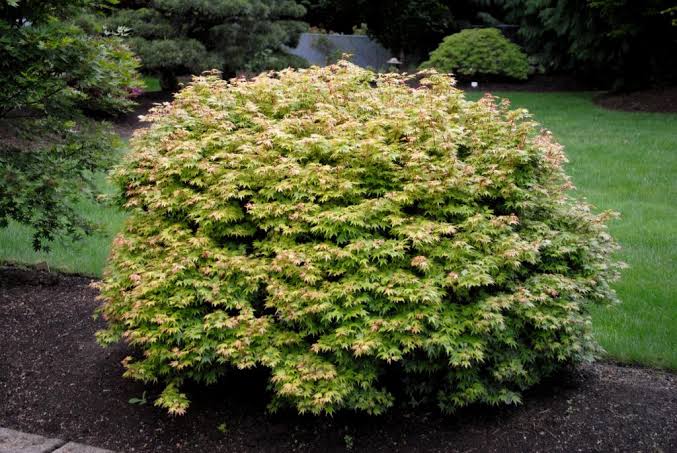
Coonara Pygmy Japanese Maple will grow to be about 6 feet tall at maturity, with a spread of 6 feet.With its dense bushy habit this super-dwarf variety is a delight year round. Coonara Pygmy Japanese Maple has attractive light green foliage which emerges pink in spring. The lobed palmate leaves are highly ornamental and turn outstanding shades of yellow, orange and red in the fall. It is not only a fine choice for the yard, but it is also a good selection for planting in outdoor pots and containers.
Also Read: Trees With Beautiful Fall Foliage
Higasayama Japanese Maple
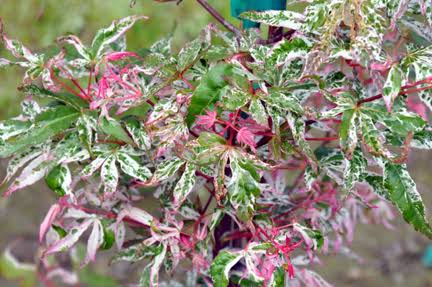
Higasa Yama Japanese Maple will grow to be about 15 feet tall at maturity, with a spread of 15 feet. Its habit is upright to almost columnar. Its relatively fine texture sets it apart from other landscape plants with less refined foliage. Higasayama starts out in spring with multicolored yellow and red, dark green and pink tones; in summer the color changes to dark green veins with white outlining. In the fall, the leaves, which have since turned all green, change to gold and red. Small reddish spring flowers are visible close up. This cultivar was named after Mt. Higasa in Japan.
Butterfly Japanese Maple
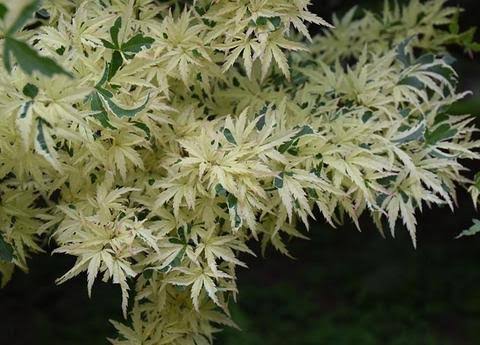
Butterfly Variegated Japanese Maple will grow to be about 12 feet tall at maturity, with a spread of 12 feet. It bears palmate, lobed, toothed, grey-green leaves with irregular, creamy-white to pink margins, the entire leaf turning orange and red in autumn. Corymbs of small, red flowers in spring are followed by winged, green fruit.Butterfly Variegated Japanese Maple is a fine choice for the yard, but it is also a good selection for planting in outdoor pots and containers.
Villa Taranto Japanese Maple
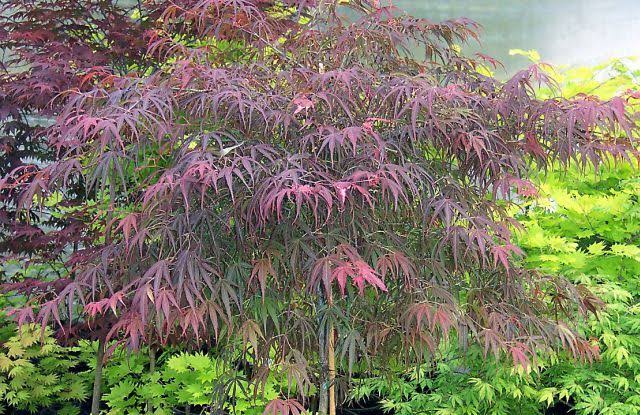
Villa Taranto Japanese Maple is an open deciduous tree with a strong central leader and a more or less rounded form. It grows to be about 10 feet tall at maturity, with a spread of 10 feet. This Japanese Maple has attractive red-variegated chartreuse foliage which emerges red in spring. The small deeply cut ferny palmate leaves are highly ornamental and turn outstanding shades of gold and red in the fall. Flowers are followed by samaras that ripen in late summer to fall.
Katsura Japanese Maple
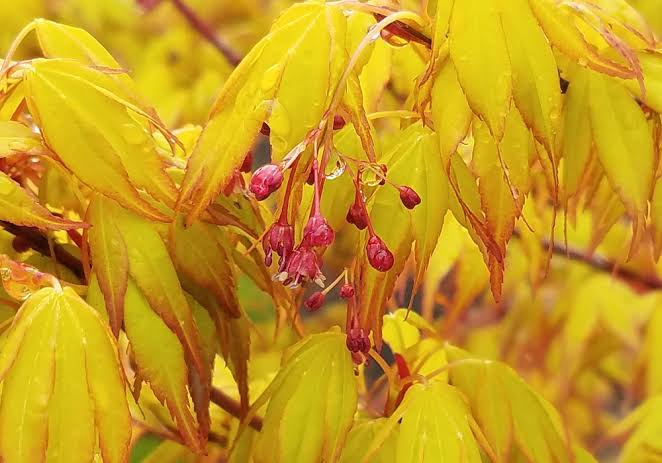
Katsura’ is a dense, compact, cultivar that is most noted for its beautiful spring foliage. Small, palmate, lobed leaves emerge chartreuse with orange-tinted margins in spring, mature to bright green by summer and finally turn pastel shades of orange and yellow in fall. Leaf lobes are lanceolate with slender tips and shallow-toothed margins. ‘Katsura’ typically grows in a vase-shaped form to 4-6′ tall over the first 10 years, but gradually becomes more rounded with age as it matures to 10-12′ tall. Small reddish flowers in spring are somewhat attractive on close inspection, but are not showy from a distance.
Sherwood Flame Japanese Maple
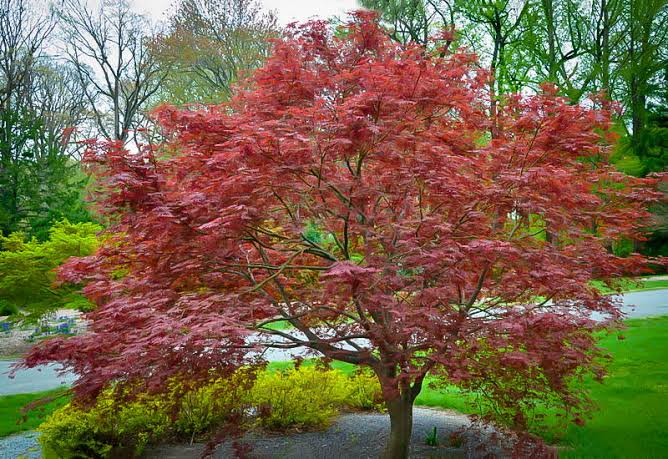
Sherwood Flame Japanese Maple is a small tree with a rounded-spreading crown that is particularly noted for its attractive reddish-purple foliage which retains excellent color throughout spring and summer. Foliage briefly fades to reddish green in early fall before intensifying to scarlet red. It typically matures over time to 14-16′ tall. Each palmate leaf has seven serrated lobes which taper to sharp terminal points. Lobes are deeply cut close to the leaf base. Showy red leaf stalks. Clusters of red samaras in fall are unusually showy. ‘Sherwood Flame’ is a seedling of Acer palmatum ‘Burgundy Lace’ but with better leaf color retention in summer.
Also Read: Types of Maple Trees
Omurayama Japanese Maple
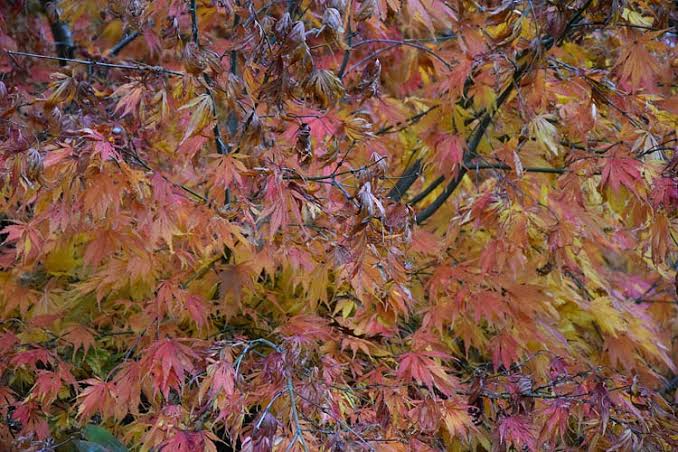
Omurayama’ is a weeping form of Japanese maple. It typically grows in an upright, rounded, cascading form to 8-10′ tall over the first ten years, eventually maturing to 10-15′ tall and as wide. Young plants are mostly upright. They develop a cascading form with maturity as the slender branches become pendulous near the tips. Palmate leaves are deeply cut into seven lanceolate lobes each having toothed margins and pointed tips. Foliage emerges light green with orange tinted margins in spring, matures to a rich green in summer and finally turns bright red, orange and gold in fall. Small reddish flowers in spring are somewhat attractive on close inspection, but are not showy from a distance.
Red Emperor Japanese Maple
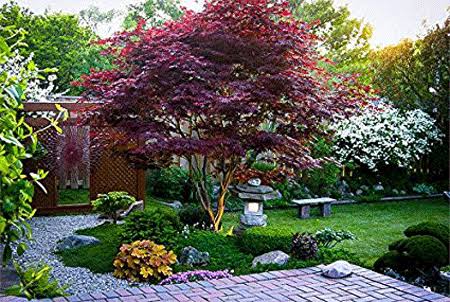
Red Emperor Japanese Maple will grow to be about 15 feet tall at maturity, with a spread of 15 feet. Red Emperor Japanese Maple has attractive dark red foliage which emerges brick red in spring. The lobed palmate leaves are highly ornamental and turn an outstanding scarlet in the fall. It features subtle corymbs of red flowers rising above the foliage in mid spring before the leaves. It produces red samaras from early to mid fall. The rough gray bark and red branches add an interesting dimension to the landscape.
Further References
- Facts About Japanese Maple: https://en.m.wikipedia.org/wiki/Acer_palmatum
- Growing a Japanese Maple Tree: https://www.gardeningknowhow.com/ornamental/trees/japanese-maple/japanese-maple-care.htm
- Colorful Japanese Maples: https://www.bhg.com/gardening/trees-shrubs-vines/trees/japanese-maples/
- Japanese Maples For Sale: https://www.fast-growing-trees.com/collections/japanese-maple-trees
- Japanese Maple Cultivars: https://plants.ces.ncsu.edu/plants/acer-palmatum/